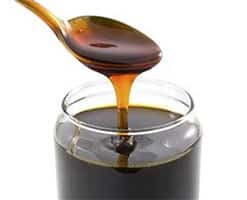 Honey is a sticky substance that bees make to feed their young. These insects sip the nectar from the flowers and transform it in the stomach, producing honey. They then return that viscous fluid through their mouths and deposit it in the combs.
Honey is a sticky substance that bees make to feed their young. These insects sip the nectar from the flowers and transform it in the stomach, producing honey. They then return that viscous fluid through their mouths and deposit it in the combs.
Although its structure may vary, the most important components of honey are carbohydrates , especially simple sugars such as glucose and fructose . It also includes disaccharides ( sucrose , isomaltose, maltose and others). These elements give it the very sweet flavor that characterizes honey.
Certain minerals and vitamins, antioxidants and amino acids are also part of honey, a product used by humans for thousands of years. Beekeeping is the activity focused on raising and caring for bees to obtain honey, royal jelly , wax and propolis .
The characteristics of honey vary according to the plants and flowers that the bees visit. It is important to note that other insects also produce honey, such as some wasps and ants .
The most common use of honey by man is in pastry and gastronomy . Honey is used as a sweetener in many recipes and as an additive in different drinks. It can even be consumed directly on bread, cookies or fruits.
In addition, honey offers benefits for the body since it works as an antiseptic and antimicrobial . Many people consume honey to relieve a sore throat, for example.
Due to its high level of sugars , however, excessive consumption can be harmful. Children under one year old should not eat honey either, since children can contract botulism due to the possible presence of bacterial spores.
It is important to note that the only type of honey that exists is not the one produced by bees, but there is also cane honey. This product does not enjoy as great a level of popularity as the first, although its properties for our health are really worth taking into account and they avoid animal exploitation one hundred percent .
Regarding its name, if we are strict we must point out that it is not exactly "honey" but rather cane " molasses ", since only bees can make honey. Despite this linguistic inconsistency, that is the name it generally receives, the one it bears on the labels and by which we will find it in stores.
 Cane honey is not a new product or recently created, but rather it emerged in Spain since the 18th century, in the Nuestra Señora del Carmen de Frigiliana factory, in the Province of Málaga. It is obtained from sugar cane, a plant that is also used in the production of rum. In this case, a type of nectar is used that contains all its nutrients .
Cane honey is not a new product or recently created, but rather it emerged in Spain since the 18th century, in the Nuestra Señora del Carmen de Frigiliana factory, in the Province of Málaga. It is obtained from sugar cane, a plant that is also used in the production of rum. In this case, a type of nectar is used that contains all its nutrients .
This juice must go through a filtration and cooking process so that it becomes a syrup, which is called molasses or cane honey. It is important to note that no chemicals or additives are added.
In cane honey we find all the benefits of the nutrients and minerals that the plant absorbs throughout its development . Given its high energy content, it is highly recommended for those who make considerable efforts daily, both mental and physical.
In addition, cane honey strengthens the hair and keeps it in good health thanks to the copper it contains, it has a laxative action, replaces sugar in case of diabetes, is ideal for weight loss diets and prevents the typical pain of osteoporosis. .
